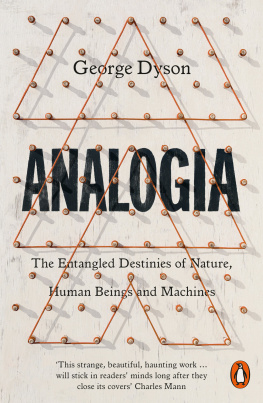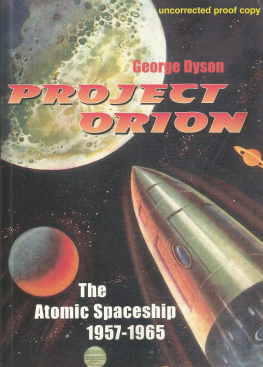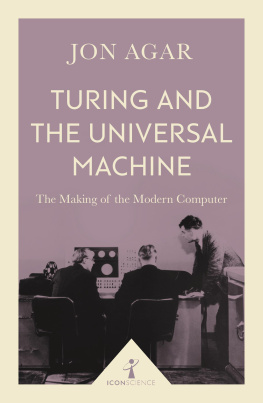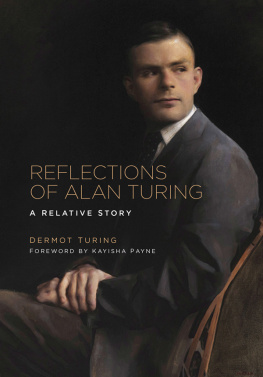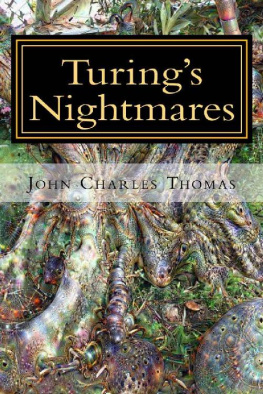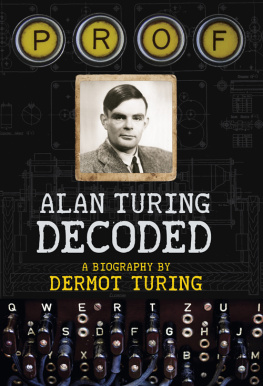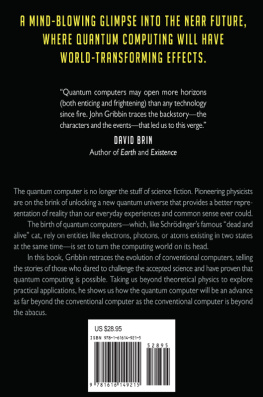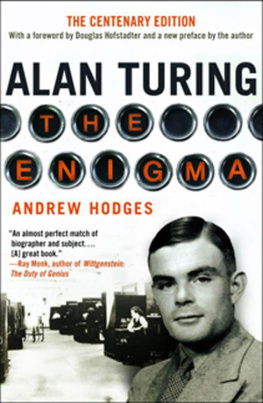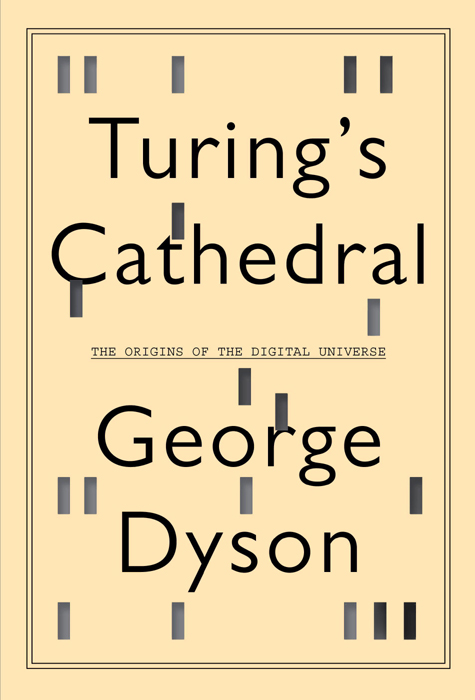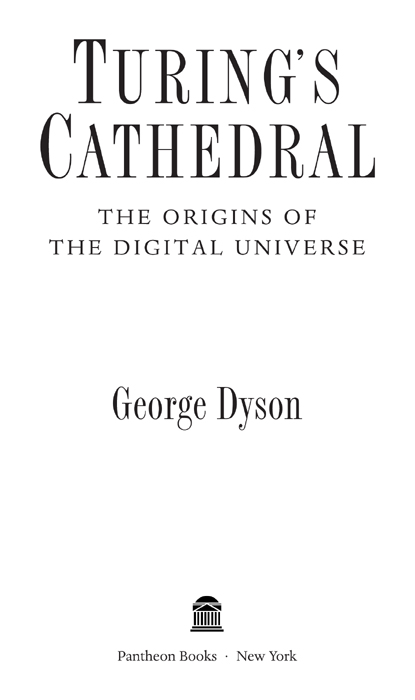ALSO BY GEORGE DYSON
Baidarka
Project Orion
Darwin Among the Machines
Copyright 2012 by George Dyson
All rights reserved. Published in the United States by Pantheon Books, a division of Random House, Inc., New York, and in Canada by Random House of Canada Limited, Toronto.
Pantheon Books and colophon are registered trademarks of Random House, Inc.
Library of Congress Cataloging-in-Publication Data
Dyson, George, [date]
Turings cathedral : the origins of the digital universe/George Dyson.
p. cm.
Includes index.
Summary: In a revealing account of John von Neumanns realization of Alan Turings Universal Machine, George Dyson vividly illuminates the nature of digital computers, the lives of those who brought them into existence, and how code took over the world.
eISBN: 978-0-307-90706-6
1. ComputersHistory. 2. Turing machines. 3. Computable functions. 4. Random access memory. 5. Von Neumann, John, 19031957. 6. Turing, Alan Mathison, 19121954. I. Title.
QA 76.17. D 97 2012 004.09dc23 2011030265
www.pantheonbooks.com
Cover design by Peter Mendelsund
v3.1
It was not made for those who sell oil or sardines
G. W. Leibniz
CONTENTS
PREFACE
POINT SOURCE SOLUTION
I am thinking about something much more important than bombs. I am thinking about computers.
John von Neumann, 1946
There are two kinds of creation myths: those where life arises out of the mud, and those where life falls from the sky. In this creation myth, computers arose from the mud, and code fell from the sky.
In late 1945, at the Institute for Advanced Study in Princeton, New Jersey, Hungarian American mathematician John von Neumann gathered a small group of engineers to begin designing, building, and programming an electronic digital computer, with five kilobytes of storage, whose attention could be switched in 24 microseconds from one memory location to the next. The entire digital universe can be traced directly to this 32-by-32-by-40-bit nucleus: less memory than is allocated to displaying a single icon on a computer screen today.
Von Neumanns project was the physical realization of Alan Turings Universal Machine, a theoretical construct invented in 1936. It was not the first computer. It was not even the second or third computer. It was, however, among the first computers to make full use of a high-speed random-access storage matrix, and became the machine whose coding was most widely replicated and whose logical architecture was most widely reproduced. The stored-program computer, as conceived by Alan Turing and delivered by John von Neumann, broke the distinction between numbers that mean things and numbers that do things. Our universe would never be the same.
Working outside the bounds of industry, breaking the rules of academia, and relying largely on the U.S. government for support, a dozen engineers in their twenties and thirties designed and built von Neumanns computer for less than $1 million in under five years. He was in the right place at the right time with the right connections with the right idea, remembers Willis Ware, fourth to be hired to join the
As World War II drew to a close, the scientists who had built the atomic bomb at Los Alamos wondered, Whats next? Some, including Richard Feynman, vowed never to have anything to do with nuclear weapons or military secrecy again. Others, including Edward Teller and John von Neumann, were eager to develop more advanced nuclear weapons, especially the Super, or hydrogen bomb. Just before dawn on the morning of July 16, 1945, the New Mexico desert was illuminated by an explosion brighter than a thousand suns. Eight and a half years later, an explosion one thousand times more powerful illuminated the skies over Bikini Atoll. The race to build the hydrogen bomb was accelerated by von Neumanns desire to build a computer, and the push to build von Neumanns computer was accelerated by the race to build a hydrogen bomb.
Computers were essential to the initiation of nuclear explosions, and to understanding what happens next. In Point Source Solution, a 1947 Los Alamos report on the This approximated the physical reality of a nuclear explosion closely enough to enable some of the first useful predictions of weapons effects.
Numerical simulation of chain reactions within computers initiated a chain reaction among computers, with machines and codes proliferating as explosively as the phenomena they were designed to help us understand. It is no coincidence that the most destructive and the most constructive of human inventions appeared at exactly the same time. Only the collective intelligence of computers could save us from the destructive powers of the weapons they had allowed us to invent.
Turings model of universal computation was one-dimensional: a string of symbols encoded on a tape. Von Neumanns implementation of Turings model was two-dimensional: the Internet can still be viewed as a common tape shared by a multitude of Turings Universal Machines.
Where does time fit in? Time in the digital universe and time in our universe are governed by entirely different clocks. In our universe, time is a continuum. In a digital universe, time (T) is a countable number of discrete, sequential steps. A digital universe is bounded at the beginning, when T = 0, and at the end, if T comes to a stop. Even in a perfectly deterministic universe, there is no consistent method to predict the ending in advance. To an observer in our universe, the digital universe appears to be speeding up. To an observer in the digital universe, our universe appears to be slowing down.
Universal codes and universal machines, introduced by Alan Turing in his On Computable Numbers, with an Application to the Entscheidungsproblem of 1936, have prospered to such an extent that Turings underlying interest in the decision problem is easily overlooked. In answering the Entscheidungsproblem, Turing proved that there is no systematic way to tell, by looking at a code, what that code will do. Thats what makes the digital universe so interesting, and thats what brings us here.
It is impossible to predict where the digital universe is going, but it is possible to understand how it began. The origin of the first fully electronic random-access storage matrix, and the propagation of the codes that it engendered, is as close to a point source as any approximation can get.
ACKNOWLEDGMENTS
IN THE BEGINNING WAS THE COMMAND LINE
Intuition of truth may not Relish soe much as Truth that is hunted downe.
Sir Robert Southwell to William Petty, 1687
In 1956, at the age of three, I was walking home with my father, physicist Freeman Dyson, from his office at the Institute for Advanced Study in Princeton, New Jersey, when I found a broken fan belt lying in the road. I asked my father what it was. Its a piece of the sun, he said.
My father was a field theorist, and protg of Hans Bethe, former wartime leader of the Theoretical Division at Los Alamos, who, when accepting his Nobel Prize for discovering the carbon cycle that fuels the stars, explained that stars have a life cycle much like animals. They get born, they grow, they go through a definite internal development, and finally they die, to give back the material of which they are made so that new stars may live. To an engineer, fan belts exist between the crankshaft and the water pump. To a physicist, fan belts exist, briefly, in the intervals between stars.


